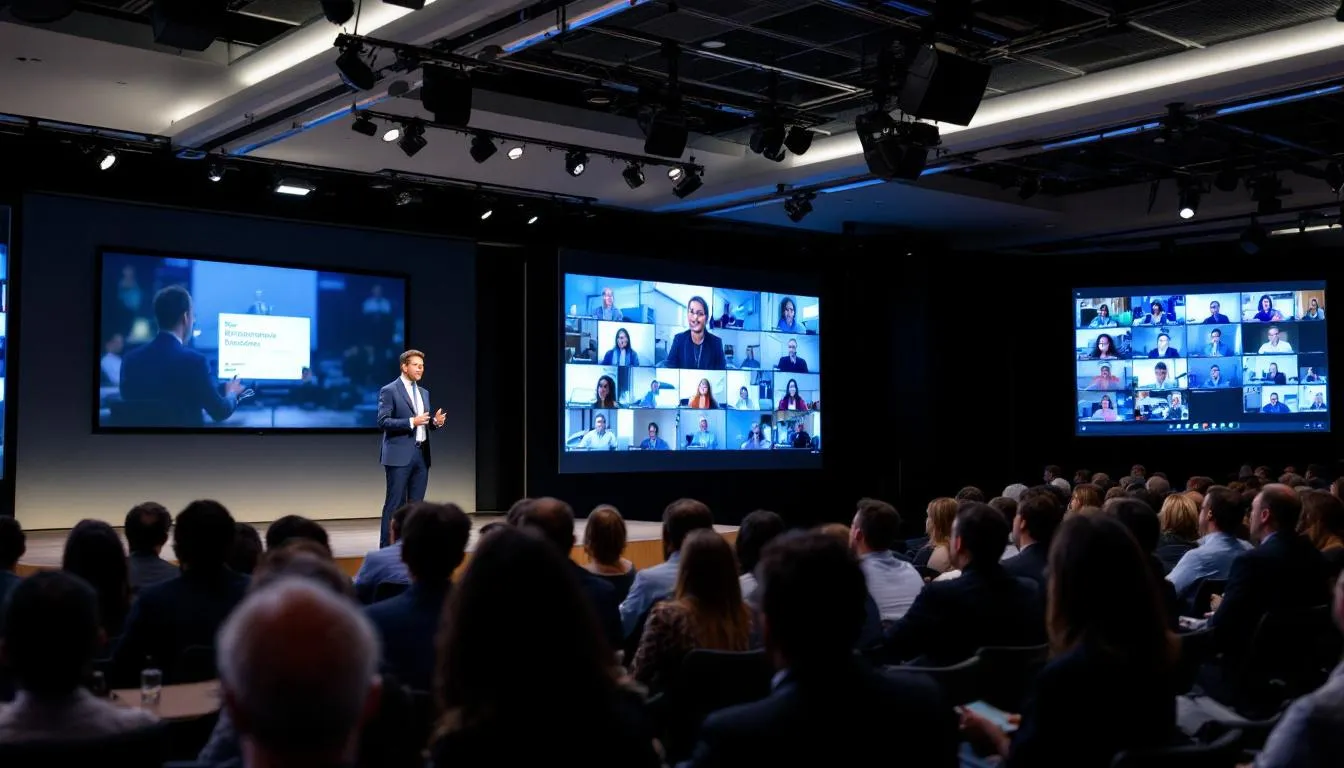
In today’s digital business landscape, organizations face increasing pressure to communicate effectively with global audiences while managing costs and maximizing reach. The traditional approach of gathering everyone in one physical location has become both impractical and expensive, particularly for multinational companies with distributed teams and customers worldwide. This challenge has driven the rapid adoption of webcasting technology as a powerful solution for modern corporate communication. Webcasts enable organizations to communicate effectively and maintain company culture, especially with remote workforces.
A webcast represents far more than just another video conference call. It’s a sophisticated broadcasting technology that enables organizations to deliver professional-quality content to thousands of simultaneous viewers across the globe, creating opportunities for engagement that were previously impossible or prohibitively expensive. Whether you’re planning a product launch, conducting employee training, or hosting investor relations events, understanding webcasting technology has become essential for business success.
This comprehensive guide will walk you through everything you need to know about webcasting, from fundamental technical concepts to advanced implementation strategies. You’ll discover how to leverage this technology for maximum business impact, avoid common pitfalls, and position your organization at the forefront of digital communication innovation.
A webcast is a live or on-demand multimedia broadcast transmitted over the internet using streaming technology, designed to reach large audiences simultaneously through a one-to-many communication format. Unlike traditional video conferencing that focuses on interactive meetings between smaller groups, webcasting emphasizes the broadcast nature of content delivery, where presenters share information with audiences that may number in the thousands or even millions of viewers worldwide. Webcasts are primarily non-interactive streams broadcasted over the internet.
The term “webcast” combines “World Wide Web” and “broadcast,” first coined in 1995 during the early days of internet streaming technology. This linguistic fusion perfectly captures the essence of what webcasting represents: taking the reach and scale of traditional broadcasting and making it accessible through web-based platforms that anyone with an internet connection can access.

What distinguishes webcasting from other digital communication formats is its architectural focus on structured content delivery rather than collaborative interaction. While participants can typically engage through features like live chat, polls, and Q&A submissions, the primary flow of information moves from presenters to audiences. This design enables webcasting platforms to support massive concurrent viewership that would be impossible with more interactive formats.
The technology serves as a bridge between traditional broadcasting and modern digital communication, offering the professional quality and broad reach of television or radio broadcasts while providing the accessibility, cost-effectiveness, and global distribution capabilities that only internet-based platforms can deliver. For businesses, this means the ability to create television-quality events without television budgets or geographic limitations.
Understanding the technical foundation of webcasting helps businesses make informed decisions about implementation and ensures successful deployment of this powerful communication technology. The process begins with content capture using professional recording equipment including high-definition cameras, quality microphones, and proper lighting systems that create broadcast-worthy video and audio feeds.
Once captured, the raw video and audio content flows into encoders - either hardware devices or software applications running on computers - that perform the critical function of converting the multimedia content into formats optimized for internet transmission. This encoding process balances multiple competing factors: maintaining professional quality standards while compressing file sizes sufficiently for efficient delivery across varying internet bandwidths and to diverse device types with different screen capabilities.
The encoded content then travels through a content delivery network (CDN), which represents the backbone infrastructure that makes global webcasting possible. CDNs consist of geographically distributed servers that work together to deliver content efficiently to audiences worldwide. When someone in Tokyo and someone in London watch the same live webcast simultaneously, they’re actually receiving the stream from different CDN servers optimized for their respective locations, ensuring minimal latency and maximum quality.

On the viewer side, the experience involves accessing the webcast through web browsers or dedicated apps that contain video players capable of decoding the incoming streams. These players automatically adjust video quality based on available bandwidth, ensuring smooth playback even on slower internet connections. The real-time processing requirements for live webcasting events demand robust technical infrastructure, as any delays or quality issues directly impact the viewer experience and can undermine the professional image organizations work to maintain.
Modern webcasting platforms handle these complex technical requirements behind the scenes, allowing businesses to focus on content creation and audience engagement rather than technical troubleshooting. However, understanding these foundational elements helps organizations select appropriate platforms, plan adequate bandwidth, and set realistic expectations for their webcasting initiatives.
The digital communication landscape offers numerous options for reaching audiences online, each with distinct characteristics that make them suitable for different business objectives. Understanding these differences helps organizations select the most appropriate format for their specific needs and avoid the common mistake of trying to use one technology for purposes it wasn’t designed to handle.
The distinction between webcasts and webinars represents one of the most important comparisons for business decision-makers to understand, as these terms are often used interchangeably despite representing fundamentally different communication approaches.
Webcasts excel at reaching large audiences, typically supporting 10,000 or more simultaneous viewers through native platform capabilities, with the potential to reach even larger numbers through integrations with social media streaming services. Webinars, in contrast, generally accommodate fewer than 1,000 participants and focus on smaller, more intimate group interactions that enable deeper engagement between presenters and attendees.
The interaction levels differ dramatically between these formats. Webinars are designed for high interactivity, featuring capabilities like screen sharing, breakout rooms, real-time collaboration tools, and extensive Q&A sessions where individual participants can engage directly with presenters. Webcasts maintain a broadcast-focused approach with limited interaction options, typically including live chat, polling, and structured Q&A submission rather than open dialogue.
These architectural differences create distinct use case scenarios. Webinars prove ideal for training sessions, educational workshops, sales demonstrations, and collaborative meetings where participant engagement drives value creation. Webcasts serve better for company announcements, product launches, keynote presentations, and formal communications where consistent messaging and broad reach take priority over individual interaction. Webinars are often designed for workshops or presentations with a small audience, while webcasts aim for broader outreach.
While both webcasts and podcasts deliver multimedia content to audiences, they operate on fundamentally different distribution models that create distinct consumption experiences and business applications. Podcasts are audio or video recordings available on-demand, while webcasts often include live streaming.
Webcasts require live streaming over the internet, creating real-time events that audiences experience simultaneously. This live streaming requirement means viewers need stable internet connections during the broadcast and must be available at specific times to participate in live events. However, this real-time nature also enables immediate audience engagement through live Q&A, polls, and chat features that create shared experiences and urgency. The term 'webcast' indicates a live streaming broadcast over the internet, contrasting with podcasts which are often pre-recorded.
Podcasts, conversely, consist of downloadable audio or video files that audiences can consume offline after downloading to their devices. This flexibility allows listeners to engage with content during commutes, exercise sessions, or other activities where live streaming would be impractical. The episodic nature of podcasts creates ongoing relationships with audiences through regular content schedules rather than event-based engagement.
From a business perspective, webcasts work better for time-sensitive communications, product launches, earnings calls, and events where immediate participation creates value. Podcasts serve educational content, thought leadership development, ongoing customer engagement, and situations where convenience and flexibility matter more than real-time interaction.
Modern webcasting technology supports multiple delivery formats, each optimized for different content types, production requirements, and audience engagement objectives. Understanding these variations helps organizations select approaches that align with their specific communication goals and resource capabilities.
Live webcasts represent the most dynamic and engaging format, transmitting content in real-time as events unfold. This format proves particularly effective for time-sensitive communications such as Apple product launches, quarterly earnings calls, and breaking news announcements where immediate participation creates significant value for audiences.
The real-time nature of live webcasts enables immediate audience engagement through interactive features like live Q&A sessions, instant polling, and real-time chat discussions. These capabilities create shared experiences that build community and excitement around events while providing immediate feedback that presenters can incorporate into their presentations.
However, live webcasting demands robust technical infrastructure to ensure stable broadcasting without interruptions, delays, or quality degradation. Organizations must prepare backup systems, test all equipment thoroughly, and have technical support readily available to address any issues that arise during live broadcasts. The inability to edit or correct mistakes in real-time means presenters must be well-prepared and comfortable with live presentation formats.
On-demand webcasts provide recorded content that audiences can access anytime, offering global convenience that accommodates different time zones, work schedules, and personal preferences. This format particularly benefits international organizations with geographically distributed audiences who cannot participate in live events due to time zone conflicts.
The asynchronous nature of on-demand content makes it ideal for training materials, educational resources, and evergreen business content that provides ongoing value long after initial creation. Organizations can build libraries of on-demand webcasts that serve as permanent resources for employee onboarding, customer education, and partner training programs.
Storage and hosting considerations become important factors for long-term accessibility of on-demand content. Organizations must plan for adequate server capacity, content organization systems, and search capabilities that help audiences find relevant materials efficiently. The ability to track viewing analytics also provides valuable insights into which content resonates most effectively with different audience segments.
Pre-recorded webcasts offer a hybrid approach that combines the production quality control advantages of recorded content with the scheduled broadcast experience of live events. Organizations create polished content in advance, then broadcast it at specific times to create shared viewing experiences.
This format enables organizations to achieve television-quality production values through multiple takes, professional editing, and post-production enhancements while still creating event-like experiences for audiences. Pre-recorded webcasts work particularly well for high-stakes corporate communications where message precision and production quality are paramount.
The scheduled broadcast approach also allows organizations to coordinate global viewing experiences by broadcasting the same content at optimal times for different geographic regions, maximizing live attendance while maintaining the excitement and engagement that scheduled events create.
Organizations adopting webcasting technology realize substantial strategic and operational advantages that extend far beyond simple cost savings. These benefits compound over time as organizations develop webcasting capabilities and integrate them into broader communication strategies.
Cost reduction represents the most immediately apparent benefit, as webcasting eliminates travel expenses associated with large-scale events. Instead of flying employees, customers, or partners to central locations for conferences, training sessions, or company meetings, organizations can reach the same audiences through high-quality webcasts at a fraction of the cost. The savings become particularly significant for multinational organizations that previously required expensive international travel for global communications.

Global reach capabilities enable organizations to engage international audiences that would be practically impossible to gather in physical locations. A single webcast can simultaneously reach team members in New York, customers in London, partners in Singapore, and prospects in Sydney, creating truly global communication experiences. This expanded reach often results in larger audiences than physical events could accommodate, amplifying message impact and organizational influence.
Scalability advantages become apparent as audience sizes grow. While physical venues impose capacity constraints and venues large enough for massive audiences often prove prohibitively expensive, webcasting platforms can support thousands of simultaneous viewers with minimal incremental costs. This scalability enables organizations to grow their communication reach without proportional increases in delivery costs.
Brand building opportunities through professional multimedia presentations help organizations project sophisticated, technology-forward images that resonate with modern audiences. High-quality webcasts demonstrate organizational competence, innovation, and commitment to effective communication, strengthening brand perception among employees, customers, and industry observers.
Data collection capabilities provide valuable insights that are difficult or impossible to gather from physical events. Webcasting platforms typically offer detailed analytics including attendance patterns, engagement metrics, viewing duration, drop-off points, and interactive feature usage. These insights enable organizations to optimize content, improve future events, and demonstrate ROI to stakeholders through quantitative metrics.
Understanding how organizations successfully deploy webcasting across different scenarios helps businesses identify opportunities where this technology can create significant value and competitive advantages.
Corporate town halls and CEO communications leverage webcasting to ensure consistent messaging reaches entire workforces simultaneously, regardless of geographic distribution. These events enable leadership to address organizational changes, share strategic updates, celebrate achievements, and respond to employee concerns in real-time. The ability to record these sessions creates permanent resources that new employees can access during onboarding processes.
Investor relations activities including quarterly earnings calls and annual meetings benefit significantly from webcasting capabilities that enable broader stakeholder participation without the logistical complexity of large physical gatherings. Organizations can accommodate analysts, institutional investors, individual shareholders, and financial journalists simultaneously while maintaining professional presentation standards that reflect positively on corporate governance practices.
Product launches and demonstrations showcase webcasting’s ability to generate excitement and urgency around new offerings while educating audiences about features, benefits, and applications. Technology companies like Apple have demonstrated how well-produced product launch webcasts can create global events that generate substantial media coverage and customer engagement far beyond what traditional launch approaches could achieve. Today, webcasts are a very popular format for independent broadcasters, news outlets, concerts, sporting events, and even weddings.
Educational seminars and training programs utilize webcasting to deliver professional development opportunities to geographically distributed teams cost-effectively. Organizations can bring expert speakers, industry thought leaders, and specialized trainers to global audiences without travel expenses while creating permanent learning resources through recorded sessions.
Conference streaming extends the reach of physical events to virtual attendees who cannot travel to conference locations. This hybrid approach maximizes event ROI by selling virtual tickets to remote audiences while enhancing the value proposition for physical attendees who appreciate expanded networking opportunities with virtual participants.
Government announcements and public communications demonstrate webcasting’s applicability beyond corporate environments. Public sector organizations use webcasting for policy announcements, public consultations, emergency communications, and citizen engagement initiatives that require broad public access and transparency.
Successful webcasting requires careful attention to both content creation equipment and software platforms that work together to deliver professional-quality experiences to audiences. Understanding these requirements helps organizations make informed investment decisions and avoid common technical pitfalls.
Video cameras represent the foundation of visual content quality, with modern webcasting demanding high-definition capabilities that maintain clarity across different viewing devices and screen sizes. Organizations should invest in cameras that support at least 1080p resolution, though 4K capabilities are becoming increasingly standard for high-profile events. Multiple camera angles help maintain visual interest and accommodate different presentation formats.
Professional microphones ensure clear audio capture, which often matters more than video quality for audience engagement and message comprehension. Wireless microphone systems provide presenters with mobility while maintaining consistent audio quality. Organizations should also invest in audio mixing capabilities that enable seamless transitions between different audio sources during presentations.
Lighting equipment significantly impacts video quality and presenter appearance, with proper lighting creating professional presentations that reflect positively on organizational image. Softbox lighting systems, LED panels, and adjustable lighting stands enable organizations to create television-quality visual presentations regardless of venue limitations.
Hardware or software encoders process raw video and audio feeds into formats optimized for internet streaming. Software encoders running on powerful computers offer cost-effective solutions for many organizations, while dedicated hardware encoders provide greater reliability and performance for mission-critical events.
Webcasting platforms like Kaltura, Brightcove, or Vimeo Live provide the software infrastructure that manages streaming, audience interaction, analytics, and content delivery. Platform selection should consider factors including maximum attendee capacity, interactive feature availability, integration capabilities with existing business systems, and pricing models that align with organizational usage patterns.
Content delivery networks ensure reliable global distribution by automatically routing viewer connections to optimal servers based on geographic location and network conditions. Many webcasting platforms include CDN services, though organizations with demanding requirements may need dedicated CDN solutions.
Registration and audience management tools enable organizations to control access, gather attendee information, send promotional communications, and analyze participation patterns. These tools often integrate with customer relationship management systems and marketing automation platforms to streamline audience engagement workflows.
Creating successful webcasts requires systematic planning and execution across multiple phases, from initial conceptualization through post-event analysis and follow-up activities. Organizations that follow structured processes consistently deliver higher-quality events that achieve their communication objectives more effectively.
The planning phase begins with defining clear objectives that guide all subsequent decisions about content, format, audience targeting, and success metrics. Organizations should identify specific outcomes they want to achieve, whether those involve educating audiences, generating leads, building brand awareness, or communicating important information. These objectives inform content strategy, speaker selection, and interactive feature utilization.
Target audience analysis helps organizations tailor content, messaging, and engagement approaches to specific viewer needs and preferences. Understanding audience demographics, technical capabilities, time zone distributions, and content preferences enables organizations to optimize timing, duration, technical specifications, and interactive elements for maximum engagement.
Content strategy development involves creating compelling presentations that maintain audience attention throughout events while delivering key messages effectively. Organizations should structure content with clear introductions, logical flow between topics, engaging visual elements, and strong conclusions that include appropriate calls-to-action.
Technical setup requires configuring equipment, testing streaming quality, and preparing backup systems to ensure smooth execution. Organizations should conduct full technical rehearsals that simulate actual event conditions, test all interactive features, verify audio and video quality, and confirm that backup systems function properly. Having technical support personnel available during live events helps address any issues quickly.
Promotion activities create awareness and drive registration through landing pages, social media campaigns, email invitations, and other marketing channels. Effective promotion typically begins several weeks before events and includes multiple touchpoints that remind audiences about upcoming webcasts while building anticipation and excitement.
Production execution involves managing live broadcasts according to professional presentation standards while monitoring technical performance and audience engagement. Organizations should designate specific roles for technical management, audience interaction monitoring, and content delivery to ensure smooth coordination during events.
Follow-up activities maximize long-term value through engagement metrics analysis, attendee feedback collection, and content archival for future use. Organizations should analyze attendance patterns, viewing duration, interaction levels, and other metrics to identify optimization opportunities for future events while maintaining relationships with attendees through relevant communications. It's crucial to assess the success of your webcast by revisiting your strategy and planning future events based on feedback.
Excellence in webcasting requires attention to numerous details that collectively create professional experiences capable of engaging large audiences and achieving business objectives. Organizations that consistently deliver high-quality webcasts follow established best practices that address both technical and content considerations.
Maintaining high production quality through professional audio and video standards has become essential as audiences grow accustomed to polished streaming content from entertainment platforms. Poor lighting, inadequate audio quality, amateurish camera work, or technical glitches can quickly undermine credibility and cause audience disengagement. Organizations should invest in quality equipment and technical expertise to meet contemporary audience expectations.
Including clear calls-to-action throughout presentations helps transform passive viewing into meaningful business outcomes. Whether encouraging audience registration for future events, directing viewers to specific website pages, or promoting product demonstrations, effective webcasts guide audiences toward desired actions through strategically placed, compelling calls-to-action that align with overall business objectives.
Engaging audiences through polls, Q&A sessions, and chat features creates interactive experiences that maintain attention and provide valuable feedback. However, organizations must balance interactivity with content flow to avoid disrupting presentation momentum. Planning specific interaction points and designating personnel to manage audience engagement helps maintain professional presentation standards while encouraging participation.
Providing multiple viewing options across different devices and platforms ensures broad accessibility and accommodates diverse audience preferences. Modern audiences expect seamless experiences whether viewing on desktop computers, smartphones, tablets, or smart televisions. Organizations should test viewing experiences across device types and provide technical support information for common connectivity issues.
Testing all technical components before going live prevents embarrassing failures that can damage organizational credibility and audience trust. Comprehensive testing should include all equipment, software platforms, internet connectivity, backup systems, and interactive features under conditions that simulate actual event environments. Organizations should also prepare contingency plans for common technical difficulties and designate technical support personnel for immediate problem resolution.
Having contingency plans for technical difficulties demonstrates professionalism and preparedness while minimizing negative impacts when problems occur. Backup internet connections, redundant equipment, alternative presentation formats, and clear communication protocols help organizations maintain professional standards even when technical issues arise.
The webcasting industry continues evolving rapidly as technological advances, changing audience expectations, and innovative business applications drive new capabilities and opportunities. Organizations that understand emerging trends can make strategic investments that position them at the forefront of communication innovation.
Integration with virtual and augmented reality technologies promises to create immersive experiences that transform passive viewing into interactive engagement. Virtual reality webcasts could enable remote attendees to feel present in physical venues, while augmented reality features might overlay additional information, interactive elements, or promotional content onto standard video streams.
AI-powered features represent another significant development area, with artificial intelligence enabling automated transcription services that create searchable content archives, real-time language translation that expands global accessibility, intelligent content recommendations based on viewer behavior, and predictive analytics that identify engagement patterns and optimization opportunities.
Enhanced interactivity through advanced polling, networking features, and gamification elements will continue blurring traditional boundaries between webcasts and more interactive formats. These capabilities enable organizations to maintain broadcasting efficiency while incorporating selective interactivity that increases engagement without sacrificing scalability benefits.
Improved mobile viewing experiences reflect broader digital consumption patterns as audiences increasingly access content through smartphones and tablets rather than desktop computers. Future webcasting platforms will prioritize mobile-responsive interfaces, touch-optimized controls, and efficient streaming protocols that minimize mobile data consumption while maintaining acceptable quality standards.
Greater personalization capabilities will enable organizations to tailor content, calls-to-action, and follow-up communications based on individual viewer characteristics, behavior patterns, and engagement history. This granular targeting increases relevance and conversion while maintaining the efficiency benefits of broadcasting to large audiences simultaneously.
Integration with broader marketing and communication ecosystems will become more sophisticated as webcasting platforms connect seamlessly with customer relationship management systems, marketing automation platforms, analytics tools, and content management systems. These integrations enable automated workflows, unified reporting, and comprehensive omnichannel strategies that position webcasting as one component of integrated communication approaches.
As webcasting technology continues advancing, organizations that embrace these innovations while maintaining focus on fundamental communication principles will create competitive advantages through superior audience engagement, operational efficiency, and strategic positioning in an increasingly digital business environment. The key lies in balancing technological sophistication with clear communication objectives and genuine value creation for audiences who choose to invest their time in webcasting experiences.